Affiliate links on Android Authority may earn us a commission. Learn more.
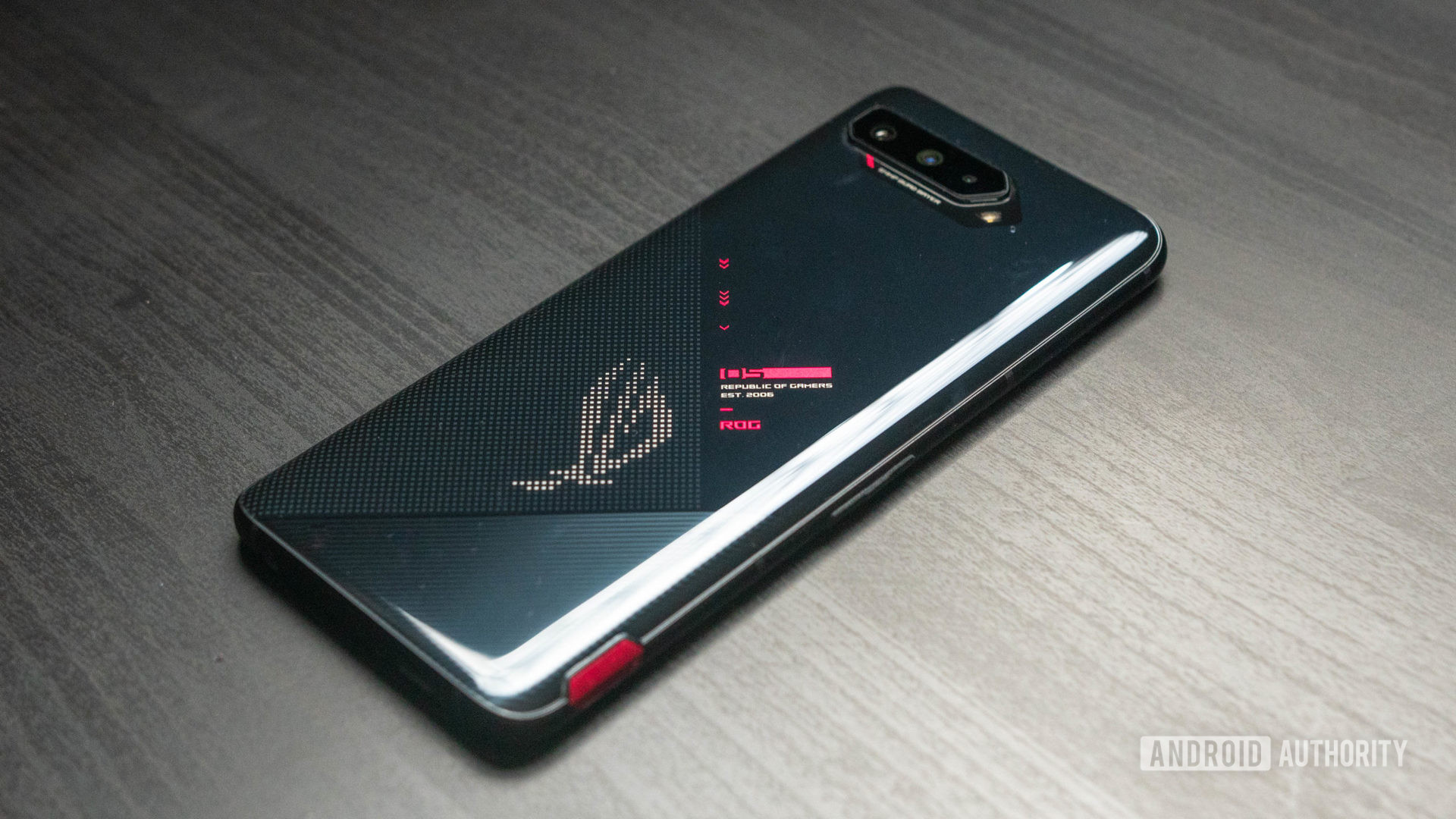


Asus ROG Phone 5
What we like
What we don't like
Our scores

Asus ROG Phone 5
The ASUS ROG Phone 3 was a fantastic device that we dubbed “the powerhouse for everyone.” We gave it our coveted Editors Choice award thanks to its ability to simultaneously be a brilliant smartphone and an excellent mobile gaming device.
The ROG Phone 5 has big shoes to fill. With updated internal components and a slightly tweaked external design, ASUS is working with what it knows as it looks to fine-tune the ROG phone formula. Is ASUS onto another winner? Find out in Android Authority’s ASUS ROG Phone 5 review.
Update, August 2021: The ROG Phone 5 now has a slightly updated model known as the ROG Phone 5s. It is pretty much the same device other than the introduction of a Snapdragon 888 Plus chipset and an increased touch response rate (360Hz). Since these devices are almost identical, this review functions as our review of the ROG Phone 5s as well.
What you need to know about the ASUS ROG Phone 5
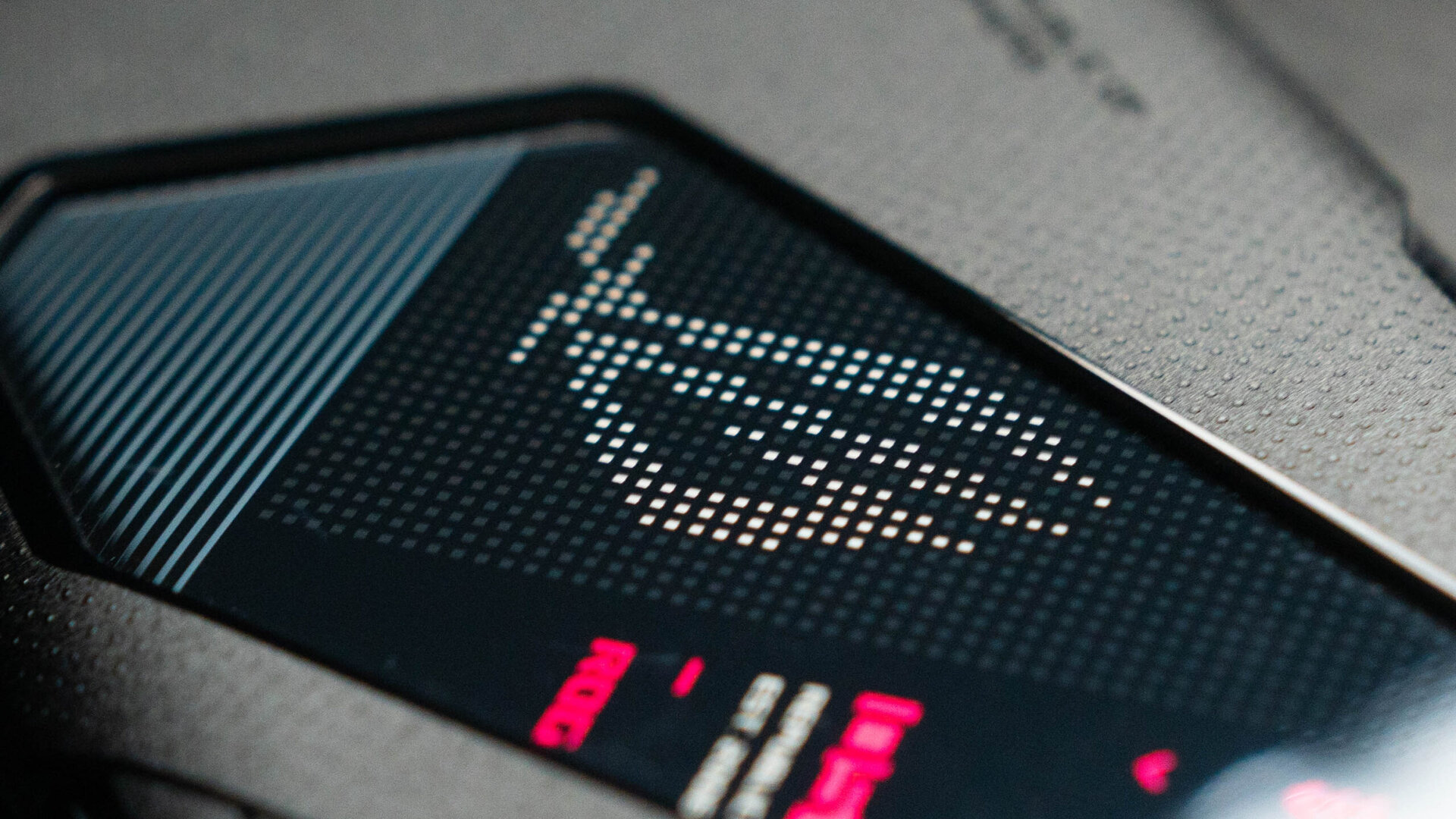
- ASUS ROG Phone 5 (8/128GB): $699.99/€799
- ASUS ROG Phone 5 (12/256GB): $769.99/€899
- ASUS ROG Phone 5 (16/256GB): $999.99/€999
- ASUS ROG Phone 5 Pro (16/512GB): €1,199 (~$1,427)
- ASUS ROG Phone 5 Ultimate (18/512GB): €1,299 (~$1,546)
The ASUS ROG Phone 5 starts at €799 in Europe and tops out at €1,299 for one of the most spec’d-out phones on the market. It comes in three different versions: the regular ROG Phone 5, the ROG Phone 5 Pro, and the ROG Phone 5 Ultimate.
In the US, you can buy the 16GB of RAM and 256GB of storage version right from ASUS for $999. So far, we have not seen the ROG Phone 5 Pro or ROG Phone 5 Ultimate launch stateside.
The regular model comes in Phantom Black or Storm White, the Pro comes in Glossy Black, and the Ultimate comes in Matte White and is a limited edition model. ASUS says some of these models will be available “in most markets,” though not through carriers. In this review, we’ll be focusing on the vanilla ROG Phone 5 variant.
The ROG Phone 5 is an out-and-out gaming phone for enthusiasts.
Do note that the ROG Phone 5s — which is functionally the same device but with a slightly upgraded chipset — will replace the regular ROG Phone 5 as stock depletes. ASUS has not announced pricing or availability for the 5s or 5s Pro yet.
ASUS is renowned for its PC business and its gaming division dubbed Republic of Gamers or ROG. After unleashing the first ROG Phone in 2018, the company has continued to establish its position as the biggest player in the gaming phone niche. Can the ROG Phone 5 continue that dominance?
Design: If it ain’t broke, tweak it

- Aluminum, Gorilla Glass Victus
- 172.8 x 77.2 x 10.29mm
- 238g
- In-display fingerprint scanner
- ROG RGB LEDs
- Dual USB-C
- Quad DAC-powered 3.5mm headphone port
- Phantom Black, Storm White
ASUS nailed the design with 2020’s ROG Phone 3 and that continues with the ROG Phone 5.
Like its predecessor, it features a large display with top and bottom bezels and stereo front-firing speakers. These are some of the best speakers that I’ve ever heard on a smartphone. They’re clear, loud, and have plenty of low-end punch. The larger bezels necessary to house the speakers are absolutely worth the trade-off here. Couple this with a Quad DAC-powered headphone port and a long Bluetooth audio codec list, and you’ve got a superb audio setup. This is a vital part of a multimedia-first device like the ROG Phone 5.
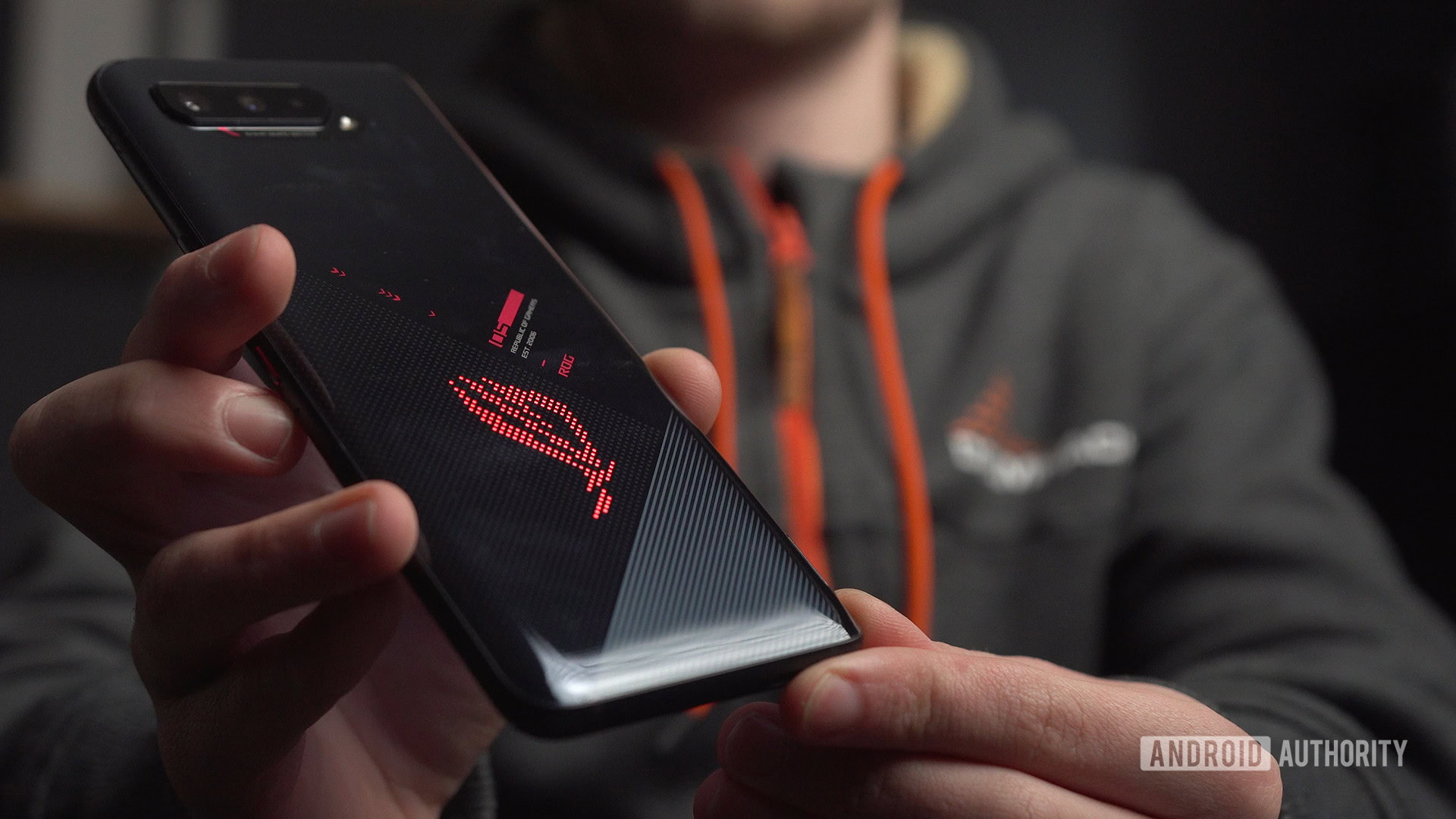
Taking a tour of the device, the top features a microphone, while the right side presents the volume rocker, an accented power button, and the two capacitive Air Triggers. On the left, there’s a SIM card tray, a secondary USB-C port, and pins for the Aero Active cooler. On the bottom, there’s a standard USB-C port and the aforementioned 3.5mm headphone jack — the latter of which makes a grand return after being removed from the ROG Phone 3. On the front, you have a large 6.78-inch display (more on that in the next section), front-firing speakers, a notification LED, and a selfie camera in the top bezel. On the back, there’s a triple camera bump near the top, some ROG gamer branding, and an RGB LED matrix in the shape of the ROG logo near the middle.
There’s a gamer theme to the ROG Phone 5’s looks, but it’s more subtle than previous iterations. Sure, there’s an RGB logo, but you can turn that off if you’re not into it. If you are, you can customize the color and lighting effect in Armoury Crate — the phone’s customization hub.
The ROG Phone 5's design is gamer-focused, but it's not over the top.
This thing is a brute and holding it in my small- to medium-sized hands, I struggled to use it without using both of them. Because it’s so heavy and thick, it can be uncomfortable to use with one hand. However, ASUS has made ergonomic optimizations like keeping the volume and power buttons near the middle of the phone. It also curved the rear glass to help the phone sit more comfortably in your hand. Holding this side-by-side with the huge iPhone 12 Pro Max, the ROG Phone 5 does a better job of catering to those with smaller hands.
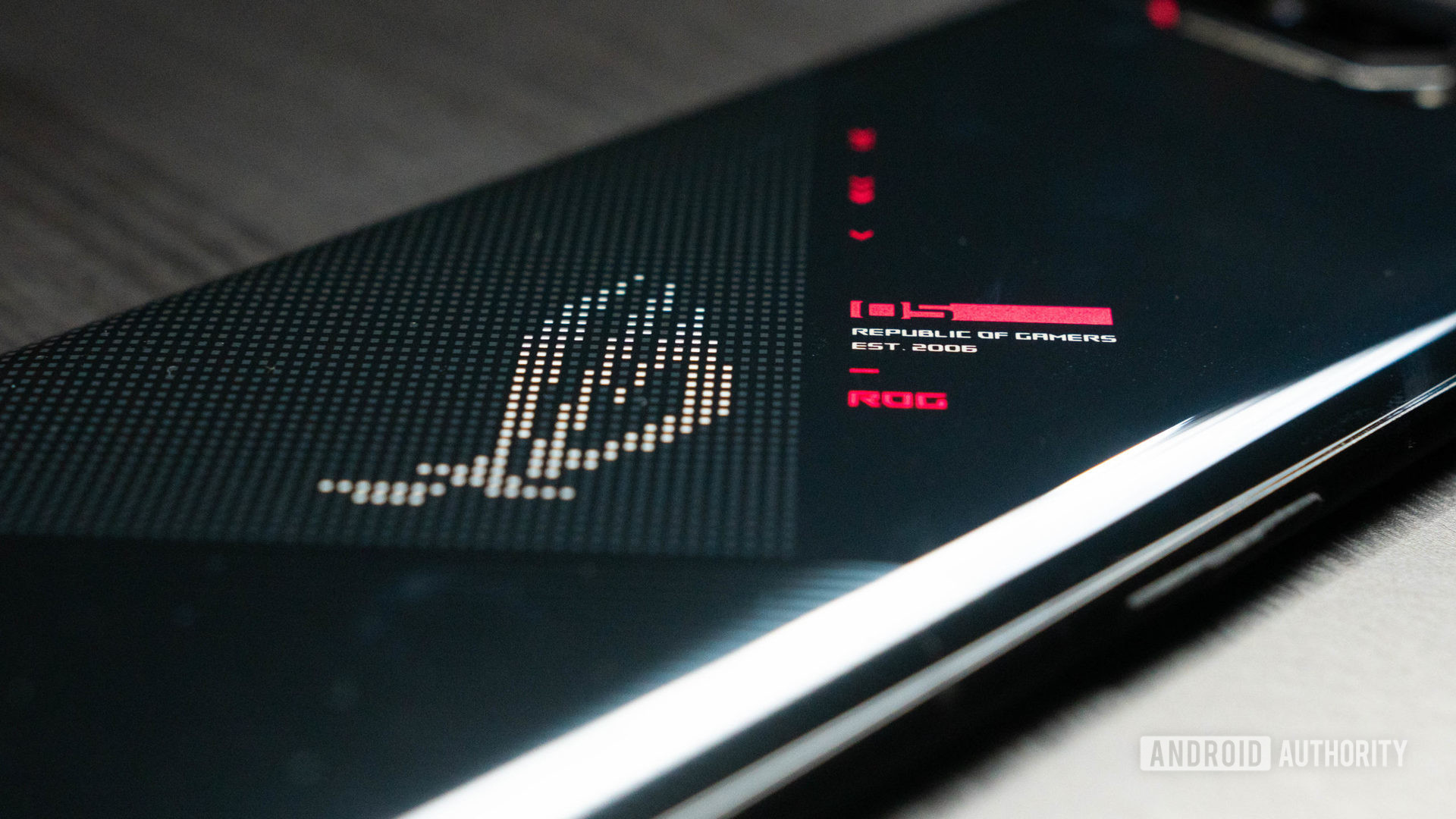
The buttons are very clicky and easy to feel out on the side of the device. The side-mounted USB-C port makes charging whilst gaming in landscape orientation more convenient. Unfortunately, the ASUS ROG Phone 5 isn’t IP rated so you’ll want to be careful when using the device near water just in case. That said, it feels very robust thanks to its use of premium build materials and hefty weight, though it should also be noted that while the front is covered by the latest Gorilla Glass Victus, the rear is only Gorilla Glass 3.
The haptics are also noteworthy; vibrations feel tight and strong. This is particularly noticeable when using the capacitive Air Triggers — two touch-sensitive buttons on the right-hand side of the device. You can map these to on-screen controls in games to make the screen as clear as possible.

One sticking point was the incredibly unreliable in-display fingerprint scanner. It took a lot longer to set up than any other in-display scanner as it would struggle to read my fingerprint. The same goes for unlocking the device. Sometimes it worked fine, though not particularly quickly. Other times it flat out refused to work. This might be something that ASUS can fix in a software update, but as it is, I wasn’t impressed.
Overall, the ROG Phone 5’s design is much like its predecessor, but with some aesthetic tweaks. It’s not going to be for everyone, but as a gaming device, it manages to balance form and function extremely well.
Display: Perfect for gaming
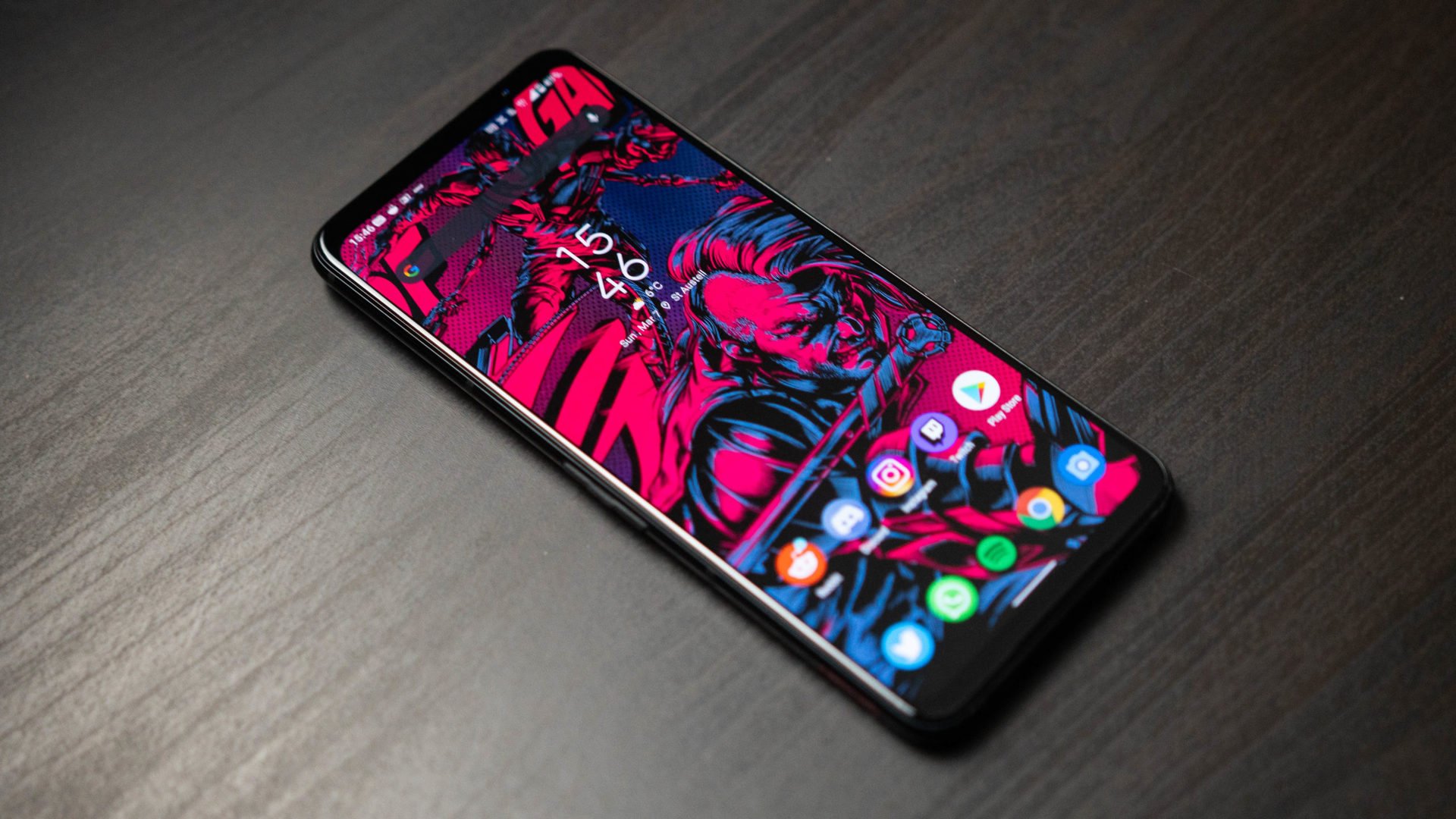
- 6.78-inch OLED display
- 2,448 x 1,080
- 395ppi
- 144Hz refresh rate/300Hz touch sampling rate
- ROG Phone 5s — 360Hz touch sampling rate
The ROG Phone 3 saw ASUS implement a fantastic 6.59-inch 144Hz OLED display. The ROG Phone 5’s screen specs are similar to that, but dialed up a notch. ASUS bumped the size to a 6.78-inch panel which makes the phone huge. However, it utilizes a taller 20.4:9 aspect ratio which makes it easier to handle when performing day-to-day tasks.
The ROG Phone 5 sports the best smartphone screen for competitive gamers.
The big, bright, hyper-responsive panel fits the bill for a competitive gamer. With its 144Hz refresh rate, 1ms claimed response time, and 300Hz touch sampling rate (360Hz for the ROG Phone 5s), this display is rapid. This is the most fluid, responsive, and natural-feeling touch screen that I’ve ever used on a smartphone. For gaming, this is ideal for those who play fast-paced titles like PUBG Mobile where having that competitive edge can mean the difference between winning and losing.

The lack of a Quad HD panel might concern some but unless you’re holding the device right up to your face, you won’t be able to tell that this is a Full HD screen. Plus, there’s an upside: the lower resolution allows the chipset to push more frames since each individual frame is easier to render, resulting in a more responsive gaming experience.
Also read: Can you really tell the difference between a Quad HD and Full HD display?
ASUS gives you the option to switch the refresh rate to 60, 120, and 144Hz with an automatic switching mode. Within the display calibration menu, there are five color modes to choose from. There’s an additional option to change color temperature and saturation too.
Thanks to ASUS’ decision to keep the screen uninterrupted, this display is very immersive. It’s big, it’s bright, it’s responsive, and it’s a clear window into the game that you’re playing. It might not be the sharpest or most vibrant, but for die-hard gamers, this is the best panel out there.
Performance: (Almost) top-notch
- Qualcomm Snapdragon 888
- ASUS ROG Phone 5s — Snapdragon 888 Plus
- Adreno 660
- 8/12/16/18GB LPDDR5 RAM
- 128/256/512GB UFS 3.1
It’s no surprise that a phone with some of the best specs on the market is one of the fastest phones on the market. The ROG Phone 5, however, isn’t the absolute fastest. In synthetic benchmarks Geekbench 4, Geekbench 5, and 3DMark, the Xiaomi Mi 11 bests it.
We also ran the ROG Phone 5 through our custom, in-house performance benchmarking software, Speed Test G. This is designed to push smartphones to their limits. The faster a phone can complete the loop, the more powerful the device is. The Mi 11 beats out the ROG Phone 5 by almost three seconds. However, the ROG Phone 5 just bests the Snapdragon 888-powered Galaxy S21 Ultra.
This performance disparity is rather minimal, but notable given the ROG Phone 5’s performance-first theme. Xiaomi is more focused on the Mi 11’s camera prowess than raw horsepower. With all that said, you’re unlikely to feel the two or three seconds of Speed Test G disparity between any of these phones in real-world use.
Outside of synthetic benchmarks, the ROG Phone 5 is very responsive. Even in a highly taxing game like Genshin Impact, I found little to no lag whatsoever. I played PUBG Mobile, Real Racing 3, and Project: Offroad 20 and was impressed with how smoothly this device ran all three.
The ROG Phone 5 doesn't quite win the benchmark war, but it's a top performer both in and out of games.
Not every game runs at 144fps and so isn’t making use of the 144Hz refresh rate. Based on the stats in the onboard Game Genie software, I found that Genshin Impact, Project: Offroad 20, and PUBG Mobile capped out at around 75fps. That’s still very high, but it’ll be a while until many games officially support 144Hz.
Performing everyday tasks like switching between five or six apps and browsing social media didn’t slow down the phone during my review time. Even processing multiple portrait mode shots was incredibly fast (though not instant) with the ROG Phone 5 thanks to its immense power.
There are four different RAM options across the three models. The regular ROG Phone 5 gets 8, 12, or 16GB. The Pro model gets 16GB RAM. Finally, the Ultimate gets a colossal 18GB RAM. Admittedly, 16 and 18GB RAM is overkill in 2021, but at least you know it’ll age extremely well. While you could save some cash on the €799 version with 8GB, I’d recommend going for the 12GB model at a minimum as you also get double the storage for all your games (256GB up from a base 128GB). Our 16GB RAM model performed tremendously well, holding apps in RAM for seemingly days at a time.
2021 SoC showdown: Snapdragon 888 vs Exynos 2100 vs Kirin 9000 vs Apple A14
The phone did get noticeably hot during long gaming sessions, however. After about five minutes of gaming, the device would start to heat up substantially. It never became uncomfortable, but it will make your fingers clammy after 15-20 minutes. ASUS does sell an Aero Active cooler accessory to keep the temperature down. This works well, but isn’t included with the regular ROG Phone 5 model, only the Pro and Ultimate variants.
Like every flagship 2021 phone, the ROG Phone 5 can deliver 5G data speeds, though I wasn’t able to test this due to the lack of 5G coverage in my area and UK lockdown restrictions. One slight downside is that the phone only supports sub-6GHz and not mmWave. This shouldn’t be a deal-breaker due to the scarcity of millimeter-wave support globally, but it’s a slight knock against the phone’s future-proofing as it won’t pick up the fastest available network speeds.
The same can’t be said for Wi-Fi though. The ROG Phone 5 supports Wi-Fi 6E — the latest and fastest Wi-Fi standard. It expands the frequency range of Wi-Fi 6 to 6GHz which can improve efficiency. It also enables extra bandwidth and channel options which can improve speed and stability. Having Wi-Fi 6E on a gaming device like the ROG Phone 5 ensures maximum data speeds when connected to a local network and helps future-proof the device.
If you’re looking for one of the fastest phones around with future-proofed specs, the ROG Phone 5 should be on your list.
Battery: Solid
- 6,000mAh
- 65W HyperCharge
Let’s talk about battery life. The ROG Phone 3 was hit and miss when it came to runtime. The ROG Phone 5 improves on this and the 6,000mAh battery setup is a solid performer. It lasted me just over a day on a charge with a mixture of gaming, watching videos, listening to music, and general social browsing. This was all with Wi-Fi and Bluetooth connections rather than mobile data connectivity.
If you’re not gaming for multiple hours at a time, expect just shy of two days of battery life. ASUS’ battery performance balancing tools are handy to eke out as much longevity as possible. X Mode favors performance, Ultra durable favors longevity, and Dynamic is a mix of the two. I completed the majority of my testing in X Mode to fully appreciate the ROG Phone 5’s power.
The battery percentage will drop rather quickly if you’re playing a lot of games in X Mode with the refresh rate dialed up. This is likely why ASUS thought to put the USB-C port on the side of the phone so that you can charge and play in landscape at the same time. It’s a handy feature that you won’t find on regular smartphones.
In an interesting move, ASUS actually split the 6,000mAh battery in the ROG Phone 5 into two 3,000mAh batteries that charge in parallel for extra speed. The phone also comes with a 65W fast charger that it calls the HyperCharge charger. The beefy brick comes in the box along with a thick, braided USB-C to USB-C cable. It also supports Power Delivery 3.0 and Quick Charge 5 so charging speeds will be decent no matter what adapter you use.
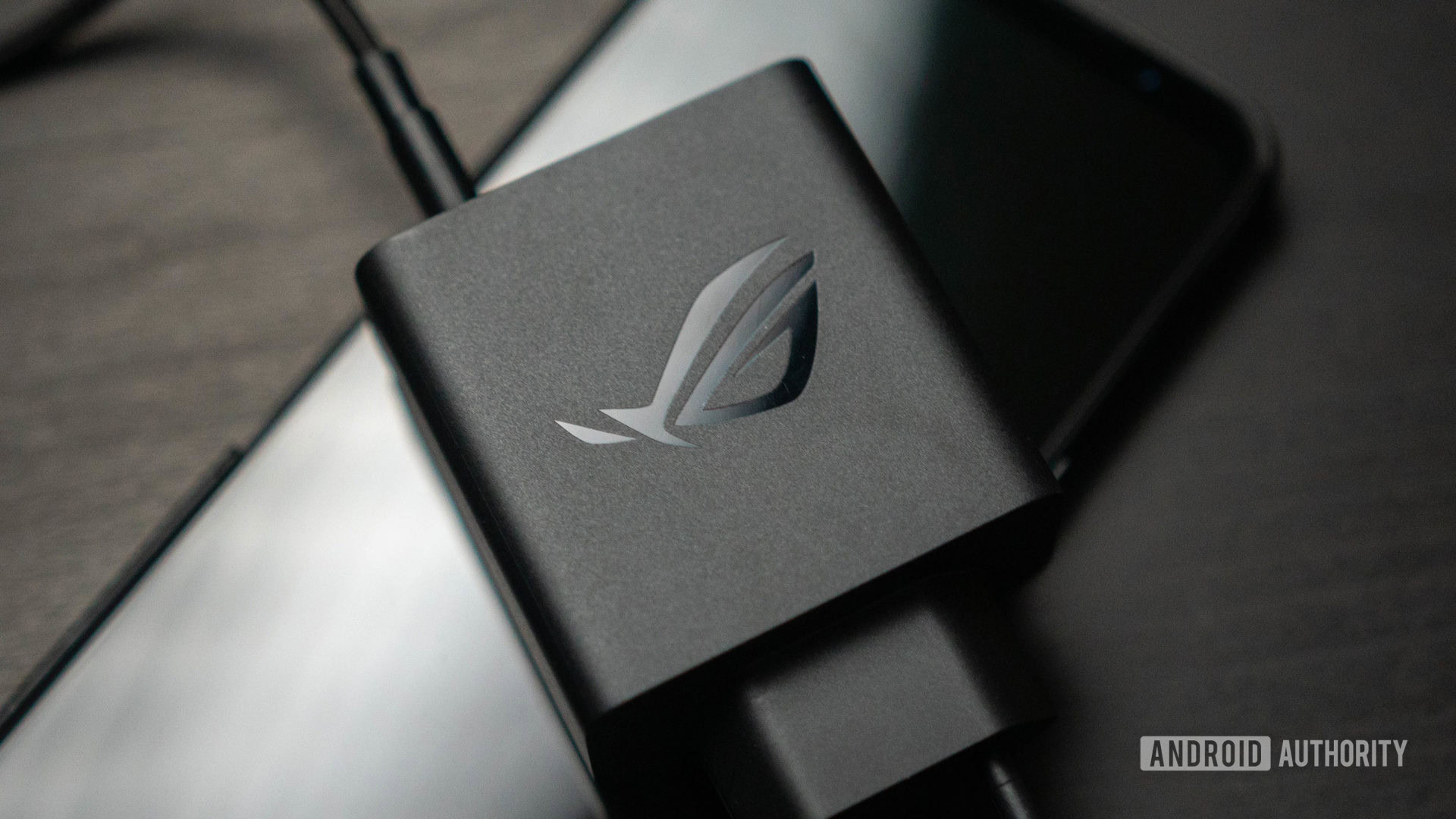
This charged the phone from zero to 100% in 55 minutes in our testing. This is very respectable for an included charger, especially when you consider the huge 6,000mAh battery capacity. It’s not the fastest charging phone you can buy, but it’s a big step up from the ROG Phone 3 which took just over 100 minutes to go from zero to 100%.
Unfortunately, there’s no wireless charging to speak of. That’s a big omission for a phone at this price. Though, the ROG Phone 5 makes up for it by including the 65W adapter in the box.
Camera: The best on a gaming phone
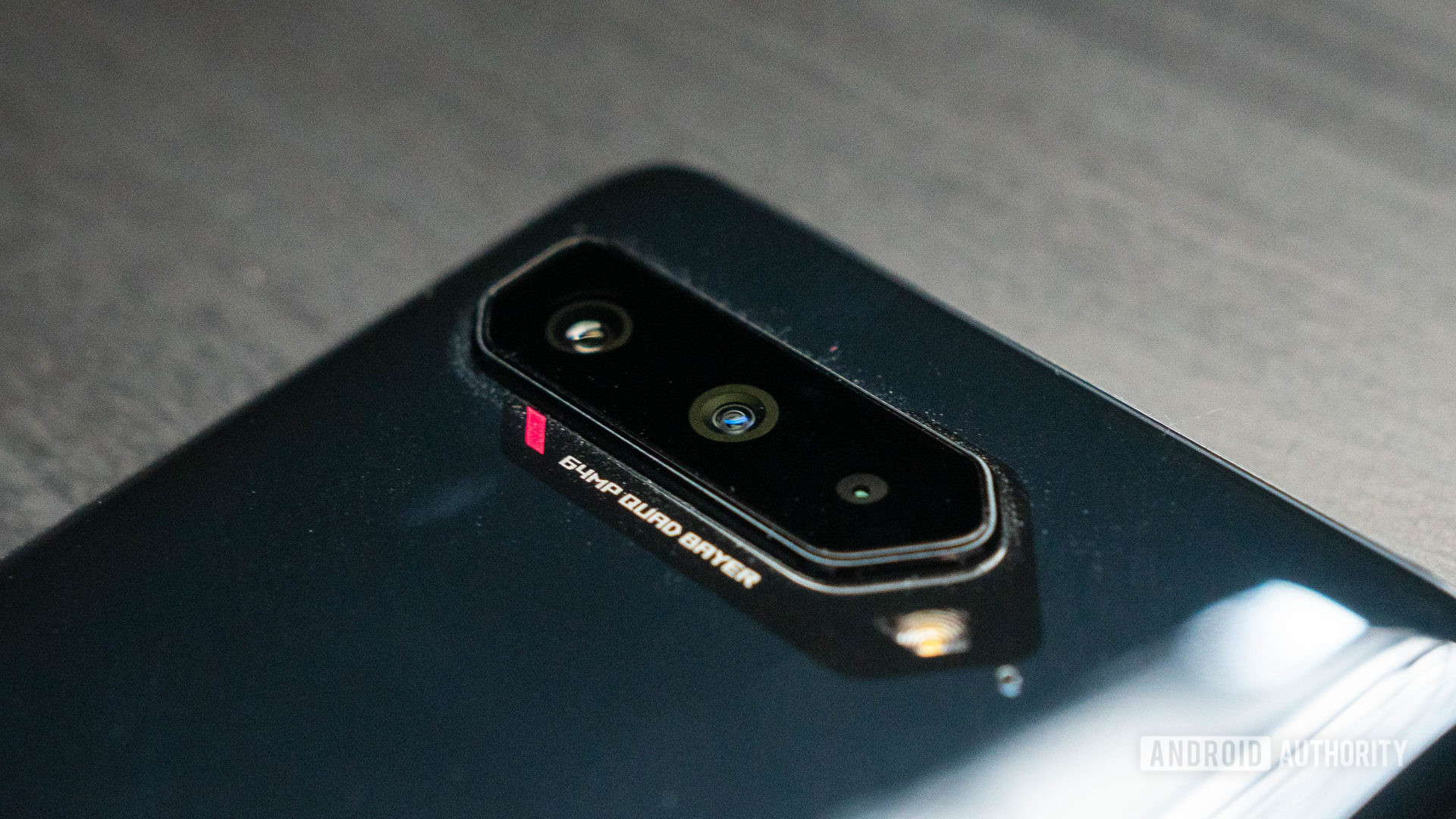
- Sony IMX686 64MP (f/1.8, 0.8um)
- 13MP ultra-wide (f/2.4, 125-degree FOV)
- 5MP macro (f/2.0)
- Front: 24MP selfie camera (f/2.45, 0.9um)
- Video: 8K at 30fps, UHD 4K at 120fps, 1080p at 240fps
Prior to launch, ASUS told us that the camera system wasn’t its focus with the ROG Phone 5, but you could have fooled me. Typically, gaming phones have had sub-par cameras. This one is an exception — at least if you’re only interested in the main camera.
Related: The best camera phones you can get
Its photos are bright, sharp, and color accurate. The 64MP IMX686 sensor is one of the larger sensors on the market at 1/1.7-inches. This means that the ROG Phone 5 performs well in low light. It also results in a natural background blur. You’re not reliant on portrait mode to get a shot with a shallow depth of field.
There’s plenty of dynamic range across the board, even in more challenging, moody scenes where shadows tend to be crushed by sub-par processing. I’m impressed with how ASUS has managed to balance aesthetically pleasing contrast with solid dynamic range. Some cameras lift the shadows too much to create a washed-out image. This isn’t the case with the ROG Phone 5.
There is a quality disparity between the main and ultra-wide cameras, but it’s not hugely jarring. However, upon cropping details, I was able to see quite a lot of sharpening artifacts, such as with the trees below. The halo-like artifacts around the branches are a result of a heavy sharpening filter. This isn’t as evident when cropping in on images taken by the main camera.
The 5MP macro camera can be rather gimmicky. It’s fun to play with for the first five minutes but after that doesn’t get much use. It’s not a bad macro camera, by any means. Macro cameras tend to produce worse quality photos than the rest of the rear camera stack. There seems to be a reasonable amount of sharpness, though dynamic range and low-light performance aren’t great and you’ll notice the lower resolution compared to other snaps. A telephoto camera would have rounded out the setup to compete with other premium phones, but what’s here is perfectly decent.
The ROG Phone 5 takes good selfies. They’re relatively sharp and color accurate. However, even with the skin smoothing option turned completely off, ASUS is still applying beautification. Portrait selfies are also rather poor. The ROG Phone 5 struggled with edge detection, especially on my lockdown mop. This results in jarringly blurred-out pieces of the image that shouldn’t be blurred, such as the various tufts of hair sticking out.
Flipping the phone back around and using the main rear camera for portrait mode shots is where things significantly improve. I was very impressed with how the ROG Phone 5 coped with shooting portraits. Edge detection was accurate, surprisingly even on Archie the dog.
While it’s not the smoothest focus roll-off, you can tell that there is some natural-looking fall-off. This is where the blur gradually gets more intense the further away from the focus plane you get. This mimics the effect of what a larger camera with a bigger sensor would give.
The ROG Phone 5 shoots video at 8K 30fps, UHD 4K up to 120fps, and Full HD up to 240fps. These are the same video modes as we saw with the ASUS Zenfone 7 Pro from last year. The main difference is that you can only shoot 1080p 60fps selfie video because this device doesn’t have the flip camera mechanism of the Zenfone. The video footage looks good. It’s rather contrast-heavy in its 8K mode, though UHD 4K 60fps footage improves on this. The UHD 4K 120fps slow-motion footage is impressively sharp — a characteristic that we saw in the Zenfone 7 Pro’s slow-mo, too.
Asus’ camera app is well laid out for the most part. However, I feel that the Panorama and timelapse modes should be swapped for Night and Macro in the model carousel. This is because they’re more likely to be used than the two that are in there. Other than that, there are plenty of modes to choose from and the layout is familiar thanks to the almost universal switch to a carousel-style setup. It’s easy to use with the flexibility for pros to change settings and get the most out of the camera.
Just like last year, ASUS has impressed us with a great camera on a device that doesn’t need the best camera system. It’s not going to best the iPhone 12 Pro Maxes or Samsung Galaxy S21 Ultras of this world and the additional sensors and the selfie camera fall short, but the primary shooter is a very good performer with great processing, backed by a solid camera app and superb slow-motion video options.
The ROG Phone 5 takes superb snaps for a gaming phone.
You can check out the full-resolution camera samples in this Google Drive folder.
Software: Fast and flexible
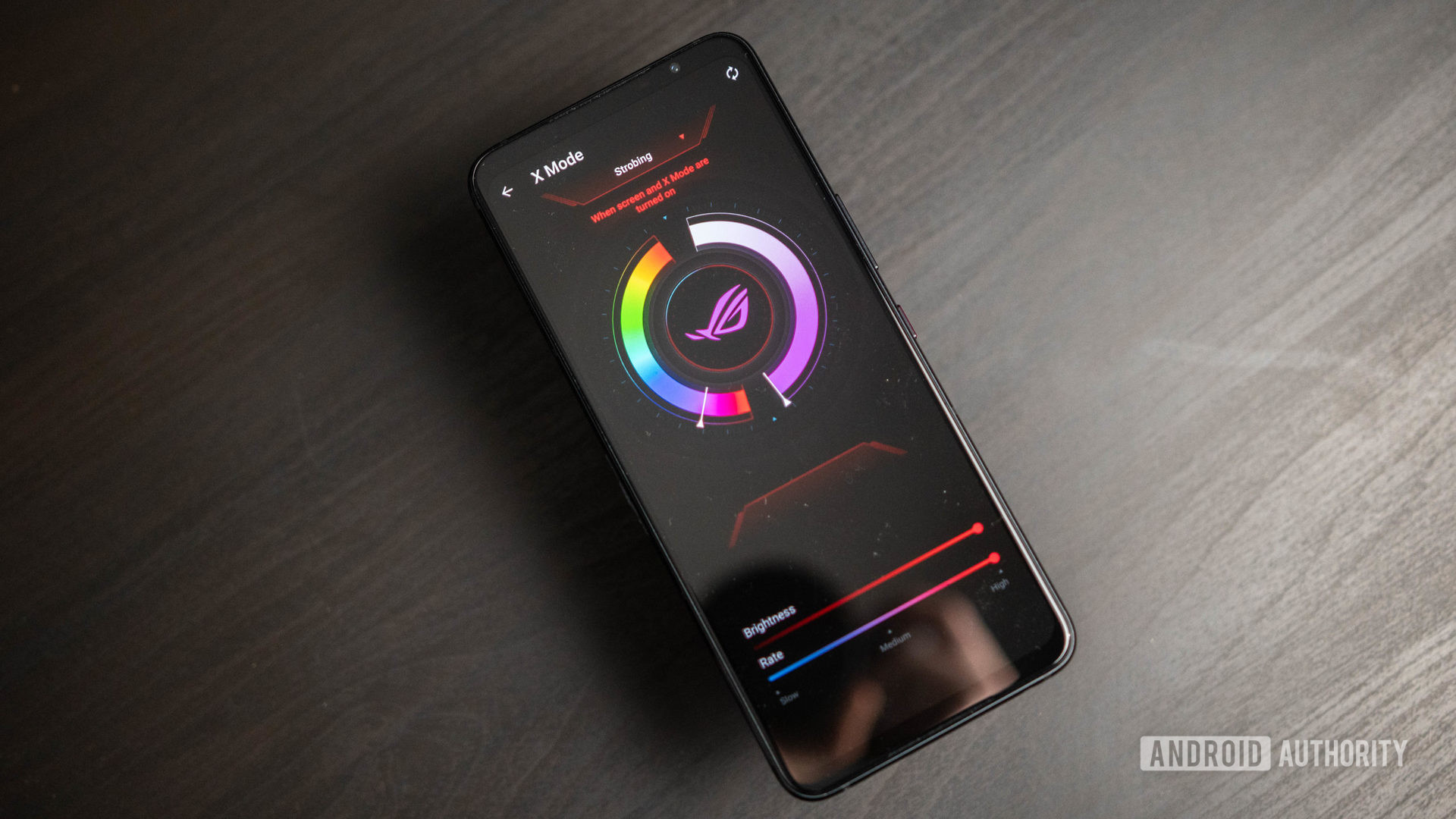
- Android 11
- ROG UI
It’s not just the camera that gets great software. ASUS’ ROG UI is a gaming Android skin done right. Right from setup, ASUS lets you choose between a gamer-friendly aesthetic and a more subtle, close-to-stock theme. This has been the case since the ROG Phone 2 and it’s still welcome here.
The more traditional skin comes very close to stock Android, though it does have some extra features and settings. That said, ASUS doesn’t cram the phone with bloat, with Instagram and Netflix the only pre-installed third-party apps. You can uninstall Instagram but only disable Netflix.
There are a few notable ROG-specific apps included. Armoury Crate lets users monitor the phone’s performance and temperature as well as customizing the hardware and software experience. It also acts as a game launcher and displays your in-game playtime alongside each title.
Asus' ROG UI is light and flexible.
In here, you can also pick your desired battery-performance balance setting, change the RGB ROG LED color, effect, and brightness, control the Aero Active cooler once connected, configure Game Genie, and adjust your Air Triggers settings. It’s a packed app with an intuitive layout and plenty of options.
Game Genie is a secondary companion app that sits over the top of your game. It’s not in the app drawer, it doesn’t interrupt your gaming experience, and you don’t even have to use it. It’s accessible from a swipe in from the left when you’re in a game. If you do use it, you’ll be greeted with a multitude of settings. You can turn off alerts, lock screen brightness, map the Air Triggers, change the screen’s refresh rate on the fly, and get real-time performance stats in a widget on your display. There are myriad other options within sub-menus too.
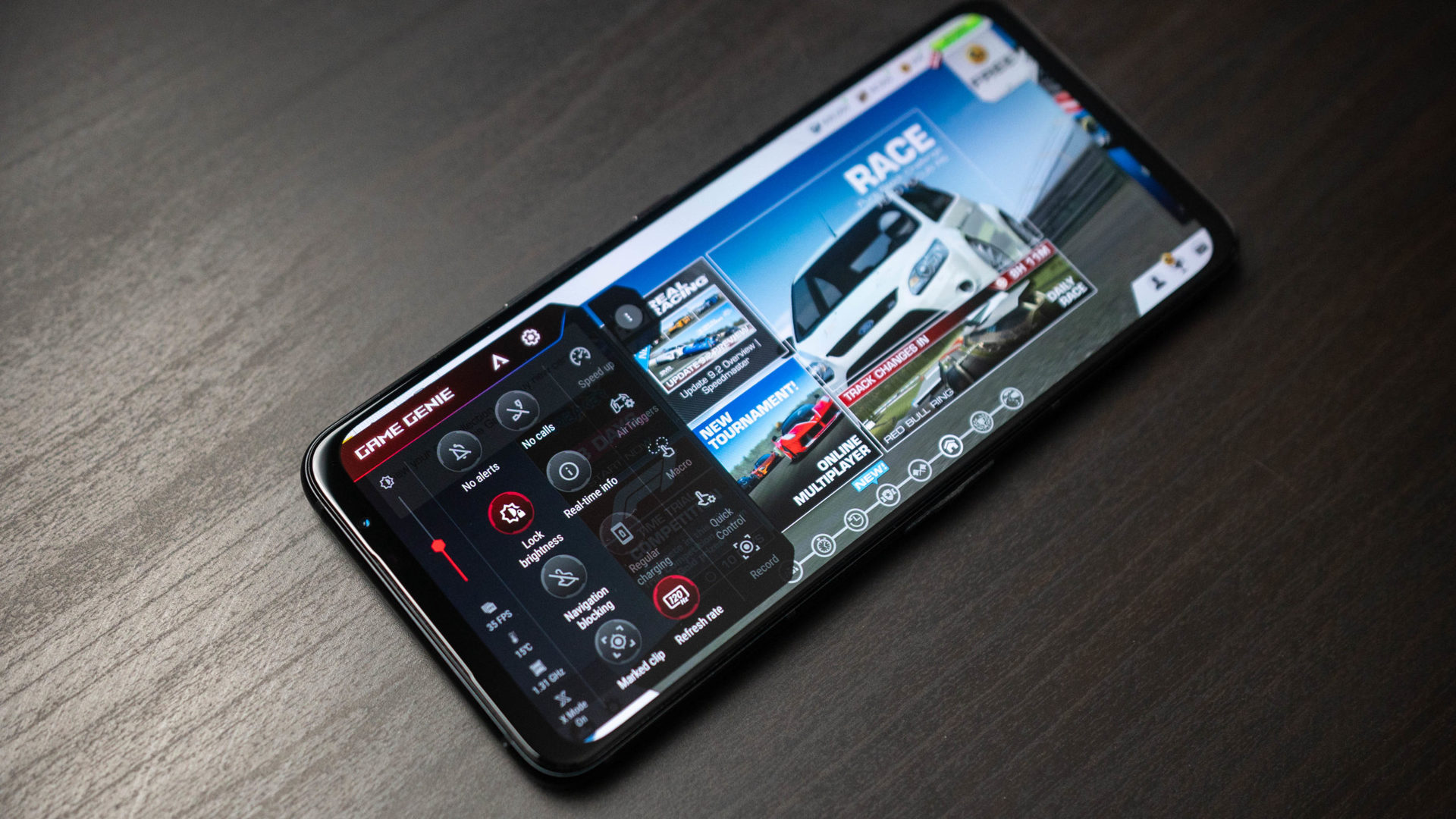
Unfortunately, there’s cause for concern when it comes to software and platform updates. On the good side, the ROG Phone 5 runs Android 11 out of the box. However, ASUS has typically been slow to rollout platform upgrades. Case in point, the ROG Phone 3 only received Android 10 in July 2021. This trend could change with the ROG Phone 5, but we haven’t had any software update promises from the company, so I wouldn’t put stock in the ROG Phone 5 getting Android 12 anytime soon after its eventual release.
ASUS ROG Phone 5 specs
| ROG Phone 5 | ROG Phone 5 Pro | ROG Phone 5 Ultimate | |
|---|---|---|---|
Display | ROG Phone 5 6.78-inch AMOLED 20.4:9 ratio 2,448 x 1,080 395ppi 144Hz 1ms response time HDR10+ Gorilla Glass Victus | ROG Phone 5 Pro 6.78-inch AMOLED 20.4:9 ratio 2,448 x 1,080 395ppi 144Hz 1ms response time HDR10+ Gorilla Glass Victus | ROG Phone 5 Ultimate 6.78-inch AMOLED 20.4:9 ratio 2,448 x 1,080 395ppi 144Hz 1ms response time HDR10+ Gorilla Glass Victus |
Rear display | ROG Phone 5 None (RGB Logo) | ROG Phone 5 Pro ROG Vision Color PMOLED | ROG Phone 5 Ultimate ROG Vision Monochrome PMOLED |
Processor | ROG Phone 5 Qualcomm Snapdragon 888 2.84GHz | ROG Phone 5 Pro Qualcomm Snapdragon 888 2.84GHz | ROG Phone 5 Ultimate Qualcomm Snapdragon 888 2.84GHz |
GPU | ROG Phone 5 Adreno 660 | ROG Phone 5 Pro Adreno 660 | ROG Phone 5 Ultimate Adreno 660 |
RAM | ROG Phone 5 Min: 8GB Max: 16GB | ROG Phone 5 Pro 16GB LPDDR5 | ROG Phone 5 Ultimate 18GB LPDDR5 |
Storage | ROG Phone 5 Min: 128GB Max: 256GB No microSD slot | ROG Phone 5 Pro 512GB UFS 3.1 No microSD slot | ROG Phone 5 Ultimate 512GB UFS 3.1 No microSD slot |
Battery/power | ROG Phone 5 6,000mAh (2 x 3,000mAh cells) 65W wired charging Charger included No wireless charging | ROG Phone 5 Pro 6,000mAh (2 x 3,000mAh cells) 65W wired charging Charger included No wireless charging | ROG Phone 5 Ultimate 6,000mAh (2 x 3,000mAh cells) 65W wired charging Charger included No wireless charging |
Cameras | ROG Phone 5 Rear: 64MP primary, 0.8μm, ƒ1.8, 1/1.7-inch sensor 13MP ultra-wide, ƒ2.4, 125-degree FoV 5MP macro, ƒ2.0 Front: 24MP, 0.9μm, ƒ2.45 | ROG Phone 5 Pro Rear: 64MP primary, 0.8μm, ƒ1.8, 1/1.7-inch sensor 13MP ultra-wide, ƒ2.4, 125-degree FoV 5MP macro, ƒ2.0 Front: 24MP, 0.9μm, ƒ2.45 | ROG Phone 5 Ultimate Rear: 64MP primary, 0.8μm, ƒ1.8, 1/1.7-inch sensor 13MP ultra-wide, ƒ2.4, 125-degree FoV 5MP macro, ƒ2.0 Front: 24MP, 0.9μm, ƒ2.45 |
IP rating | ROG Phone 5 None | ROG Phone 5 Pro None | ROG Phone 5 Ultimate None |
Audio | ROG Phone 5 3.5mm headphone port HyperStream II Quad-DAC Dual front-facing speakers Bluetooth 5.2 LDAC + aptX support | ROG Phone 5 Pro 3.5mm headphone port HyperStream II Quad-DAC Dual front-facing speakers Bluetooth 5.2 LDAC + aptX support | ROG Phone 5 Ultimate 3.5mm headphone port HyperStream II Quad-DAC Dual front-facing speakers Bluetooth 5.2 LDAC + aptX support |
Ports | ROG Phone 5 Side-mounted USB-C port Bottom USB-C port 3.5mm port Dual-SIM, dual-standby (DSDS) | ROG Phone 5 Pro Side-mounted USB-C port Bottom USB-C port 3.5mm port Dual-SIM, dual-standby (DSDS) | ROG Phone 5 Ultimate Side-mounted USB-C port Bottom USB-C port 3.5mm port Dual-SIM, dual-standby (DSDS) |
Wireless | ROG Phone 5 Wi-Fi 6E support IEEE 802.11 a, b, g, n, ca, ax Bluetooth 5.2 NFC support | ROG Phone 5 Pro Wi-Fi 6E support IEEE 802.11 a, b, g, n, ca, ax Bluetooth 5.2 NFC support | ROG Phone 5 Ultimate Wi-Fi 6E support IEEE 802.11 a, b, g, n, ca, ax Bluetooth 5.2 NFC support |
Extra sensors | ROG Phone 5 Air Triggers 5 | ROG Phone 5 Pro Air Triggers 5 Two rear touch sensors | ROG Phone 5 Ultimate Air Triggers 5 Two rear touch sensors |
Software | ROG Phone 5 Android 11 ROG UI or ZenUI | ROG Phone 5 Pro Android 11 ROG UI or ZenUI | ROG Phone 5 Ultimate Android 11 ROG UI or ZenUI |
Dimensions and weight | ROG Phone 5 172.8 x 77.2 x 10.29mm 238g | ROG Phone 5 Pro 172.8 x 77.2 x 10.29mm 238g | ROG Phone 5 Ultimate 172.8 x 77.2 x 10.29mm 238g |
Colors | ROG Phone 5 Phantom Black Storm White | ROG Phone 5 Pro Glossy Black | ROG Phone 5 Ultimate Matte White |
Value and competition
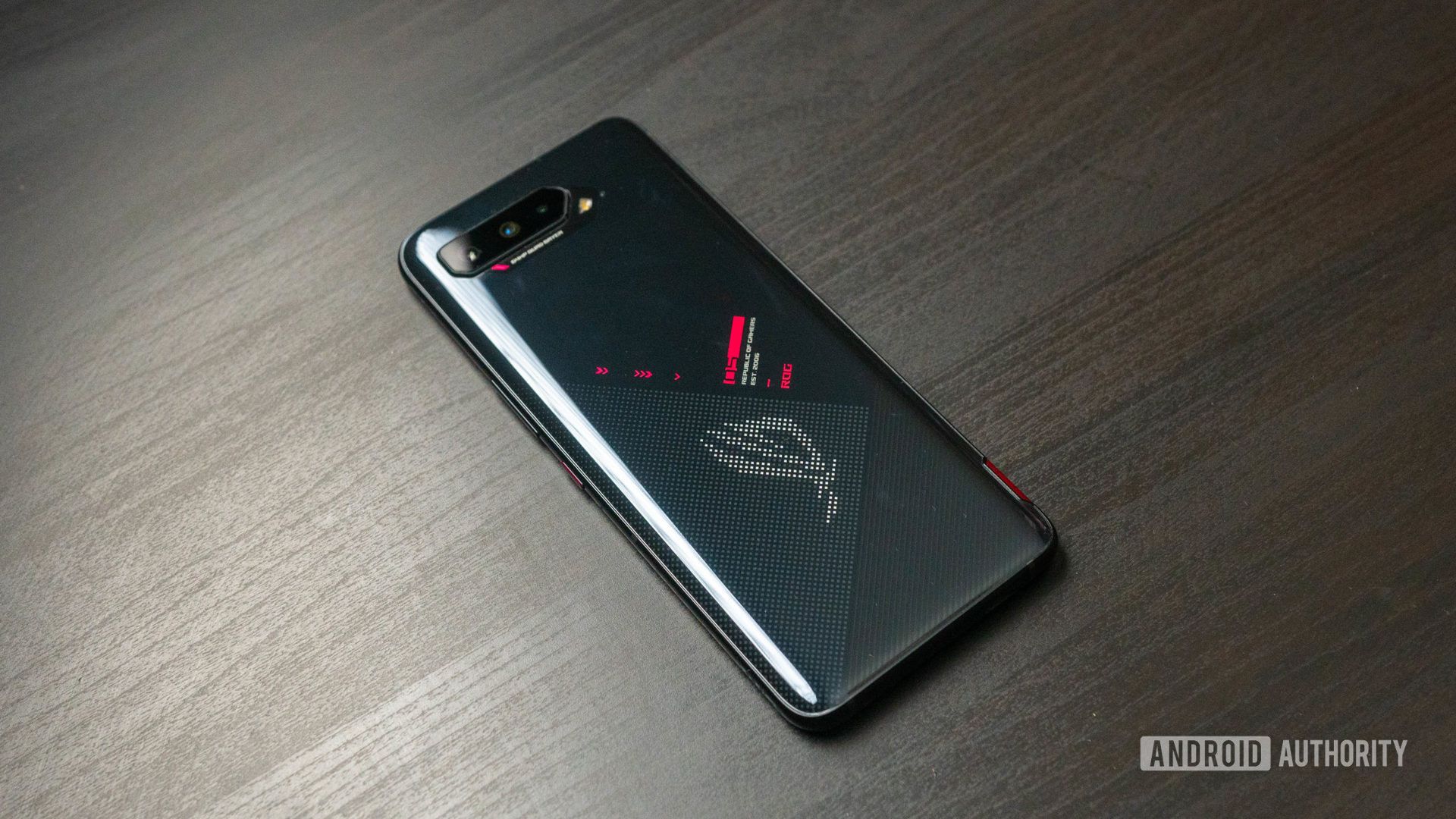
This review has focused on the standard ROG Phone 5, but there are two other variants to talk about. The ASUS ROG 5 Pro gains two touch sensors on the rear and a small color PMOLED display on the back which ASUS calls ROG Vision. It comes with the Aero Active Cooler 5 in the box too. Likewise, the ROG Phone 5 Ultimate edition shares many of the same features as the Pro version. However, it has a monochromatic ROG Vision screen on the back as opposed to a color display. ASUS will also offer a fan package with the ROG Phone 5 Ultimate edition which comes with some fancy merchandise.
Asus’ ROG Vision display, in a similar vein to the RGB logo on the back, is simply for aesthetics. It doesn’t function as a second screen per se, rather it displays GIFs and images. It isn’t touch-sensitive either, so functionally it’s rather unimportant. If you’re into that, then ASUS gives you the option to have a small display on the back of your phone. The two touch sensors add even more optional inputs for gameplay, but are hard to feel out, finicky, and are configured for swipes rather than presses. Personally, I’d rather have the regular ROG logo on the back and keep the price down.
The standard ROG Phone 5 model strikes a nice balance between hardware and pricing. The Pro and Ultimate are complete overkill, but enthusiasts may be tempted.
I’d recommend the variant that we have which is the standard ROG Phone 5 in the max-spec 16GB RAM and 256GB storage options for $999 (€999), or if you want to save some money the 12GB/256GB model for $769 (€899) is also a good bet. Compared to the Pro and Ultimate editions, you’d only be missing out on an extra 2GB RAM, another 256GB storage, and the slightly tweaked design and colorways, and the bundled Aero Active cooler. For enthusiasts, the Pro and Ultimate variants may be a tempting option, but for everyone else, they are complete overkill.
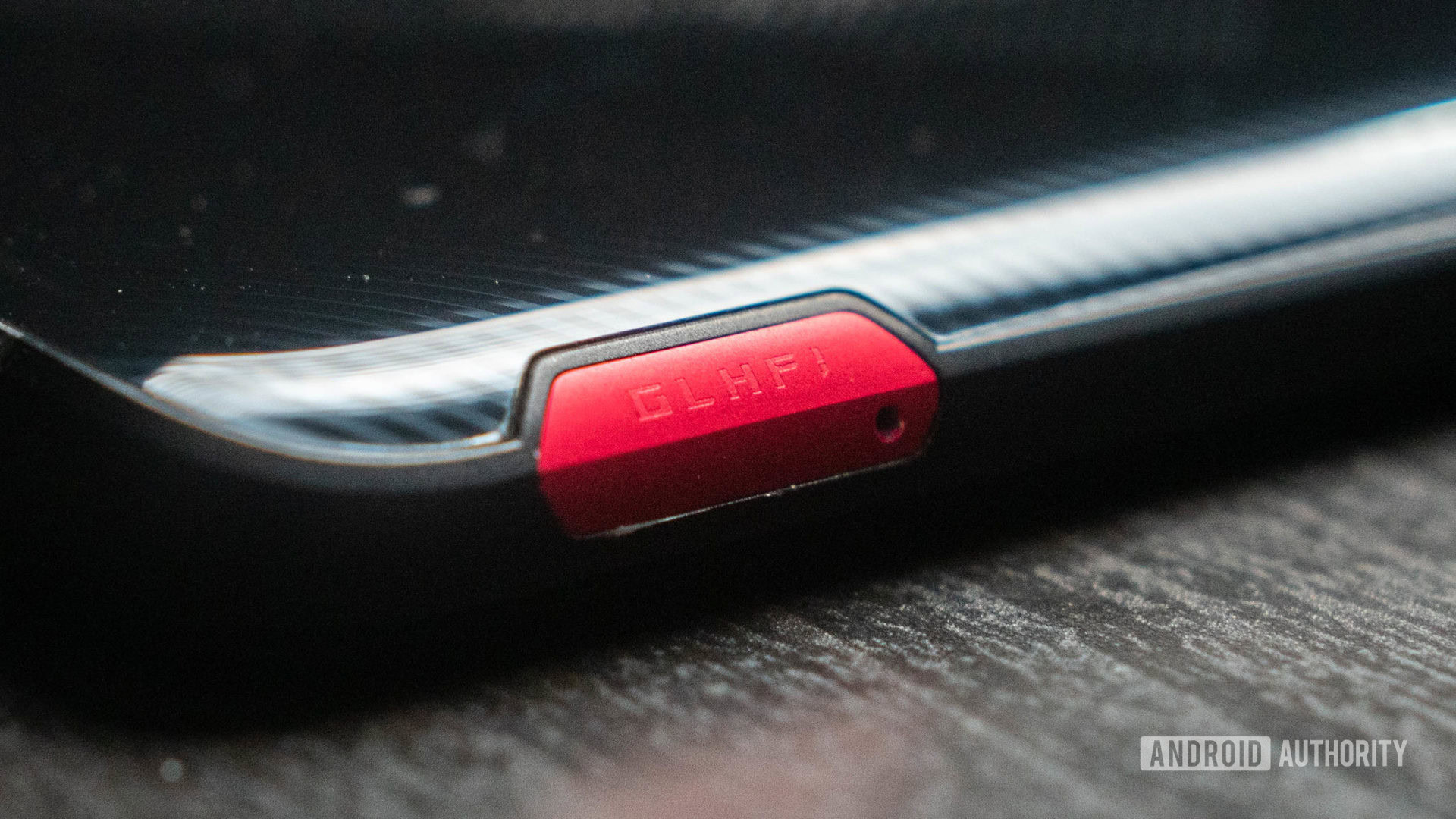
The gaming phone niche is a small section of the smartphone market, but the options are growing considerably thanks to efforts from Lenovo and REDMAGIC. We’ve recently reviewed the powerful Lenovo Legion Duel 2 ($699), with its horizontal design and dual fan setup. You might also consider the REDMAGIC 6 ($599) with its impeccable hardware package and a more affordable starting price than the ROG Phone 5, though it doesn’t offer quite as polished of an experience.
You’ll get a Snapdragon 888 processor onboard no matter which way you go, as well as upwards of 5,000mAh of battery space. Lenovo’s device is likely the more stylish of the two, though it’s not exactly a featherweight. The REDMAGIC 6 also has some software shortcomings that you may want to consider first.
Compared to other regular smartphones around the standard edition’s $769-$999. price point, the ROG Phone 5 isn’t as well-rounded as a Samsung Galaxy S21 Plus ($999) or an Apple iPhone 12 Pro ($999). However, ASUS’ phone brings unique value thanks to its gaming-focused hardware and extensive software customization options.
Do keep in mind that we still don’t know pricing or availability info for the slightly-upgraded ROG Phone 5s and 5s Pro. If you’re looking to buy soon, it might be a good idea to wait and see if ASUS is planning on dropping the price.
On a final note on value, the ROG Phone 5 also enjoys a small library of first-party accessories. The Kunai 3 gamepad ($149) is a lot like the Nintendo Switch Joy-Con controllers in that it’s made up of left and right modules that can be mix and matched. ASUS also sells its Aero Active Cooler 5 which clips on the back of the device and cools the phone. It also features two additional back buttons that can be set up in Armoury Crate for even more ways to play. ASUS has yet to confirm pricing for that one, but we’ll update this review when we have more information.
ASUS ROG Phone 5 review: The verdict
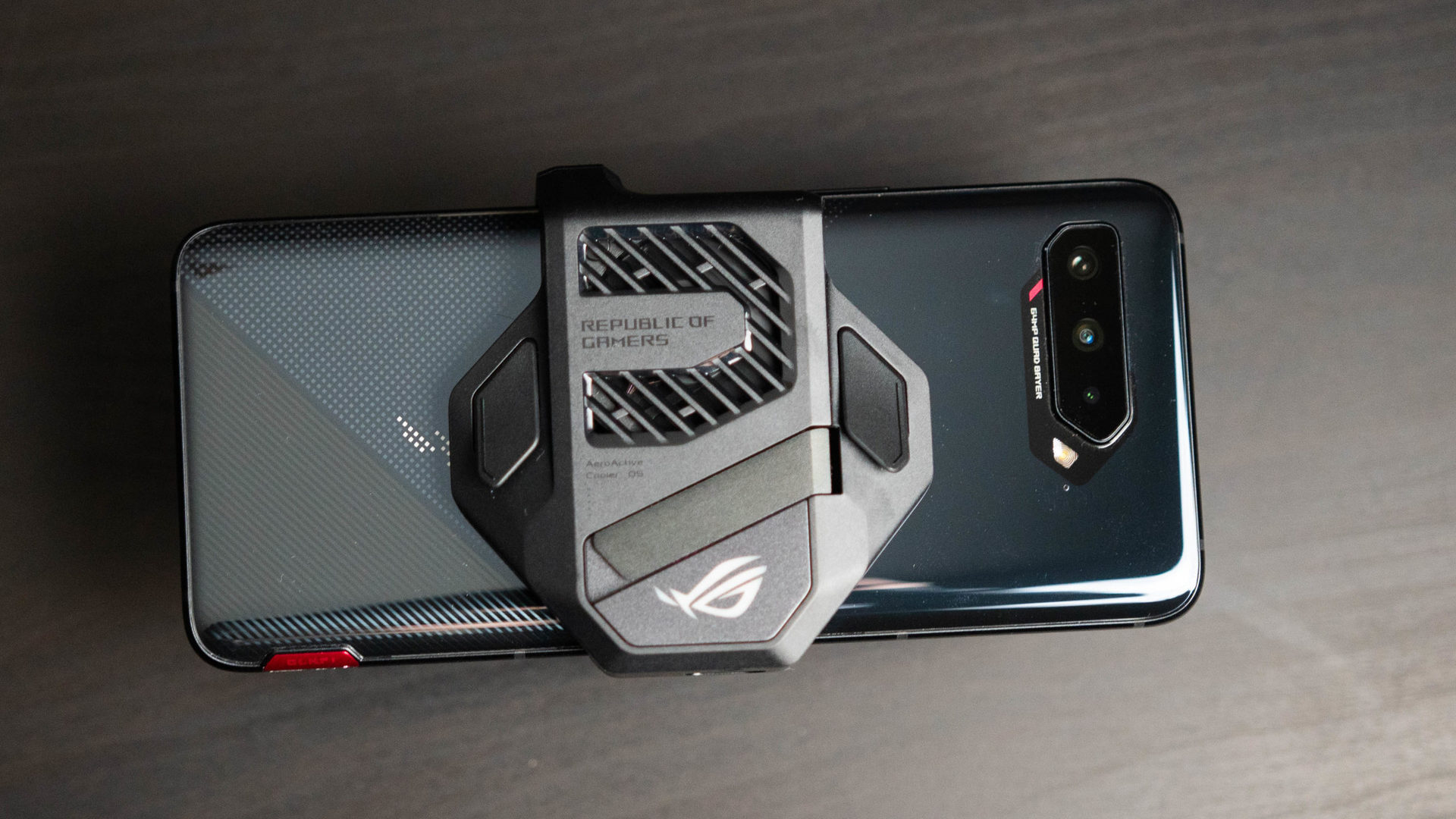
Last year’s ROG Phone 3 was a brilliant device and the ROG Phone 5 builds on this to create a balanced, up-to-date gaming powerhouse. You know what they say: if it ain’t broke, don’t fix it. ASUS has clearly heard the phrase and it’s paid off.
As of mid-2021, the ROG Phone 5 is the best gaming phone on the market. It boasts fast and fluid performance, a display that’s perfectly tuned for gaming, best-in-class audio, solid battery life, a surprisingly impressive main camera, plentiful additional hardware features, and the software experience is fully featured and well-balanced.
The ROG Phone 5 is the best gaming phone you can buy right now.
It’s not perfect, of course. The additional cameras can’t hang with the main shooter, ASUS’ software update track record for the ROG Phone series is spotty at best, the lack of wireless charging and an IP rating stings, and the fingerprint reader is awful. But for anyone looking for a gaming-first smartphone, the sheer excellence on offer where it counts makes the ROG Phone 5 stand above the competition.
With the ROG Phone 5s being basically the same phone but with a better chipset and faster touch sampling rate, we can only assume it will be of the same (or better) caliber.
The ROG Phone 5 is the new king of the hill — can anyone take its crown?